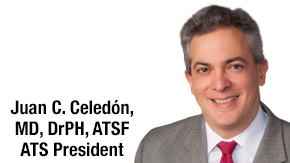To turn on the news today is to see all eyes fixed on the possibility of a COVID-19 treatment, or better yet, a vaccine that will allow us to freely gather again with friends and families. Since its foundation in 1905, the ATS has held research as a core value. Today, our society remains more committed than ever to support, disseminate, and  advocate for research in pulmonary, critical care, and sleep medicine.
advocate for research in pulmonary, critical care, and sleep medicine.
Why? First and foremost, research leads to better means to prevent, cure, or alleviate the suffering caused by respiratory diseases, as illustrated by major advances in managing conditions such as neonatal respiratory distress syndrome, tuberculosis, and HIV disease. Second, research is a sound investment. Improved preventive and therapeutic approaches reduce disability and health care costs, prolong productive lives, and create jobs. In the words of the philanthropist Mary Lasker, “If you believe that research is expensive, try disease!” Finally, those engaged in research derive satisfaction from contributing to scientific knowledge and serving our patients.
Education, training, and mentoring are key to developing future leading scientists. The ATS Research Program was established specifically to support and nurture early-career researchers as they create the body of work required to obtain funding from sources such as the NIH. As a Society, we understand how easy it is for promising researchers to be lost for lack of early funding. Such a broken pipeline ultimately results in fewer medical breakthroughs and needless patient suffering. Members are at the heart of the funding required to support ATS research initiatives, and I urge everyone to support the Research Program.
Innovation and discovery are increasingly a team effort requiring multiple perspectives and areas of expertise, underscoring the critical importance of diversity in research at the basic, translational, and clinical levels. Indeed, many of our members value the connections they make at the annual ATS international conference, which often lead them to add new collaborators or different angles to their work, ultimately improving their research. Though taking ATS 2020 online took us by surprise, I am excited to see how extending the window of opportunity for our community to collaborate via ATS 2020 Virtual impacts new and ongoing collaborations. For example, ATS 2020 Virtual attendees have access to e-posters through Nov. 10 and can directly message the authors. What new ideas for research or patient care may result from this unique structure? Only time will tell.
Following presentation at a conference(s), novel research findings must be distilled and disseminated to the medical and scientific communities, so that rigorously evaluated evidence is used to inform and support new directions in health policy, public health, or treatment. This critical component of our mission falls to our ATS journals, which continue to lead the field with great distinction.
Lastly, our Public Advisory Roundtable adds patient voices to the chorus, highlighting key research needs while reminding us of our ultimate goal of helping patients. Indeed, many of us know that research paths can begin or change based on patterns we’ve seen in our patients. My own research career was fueled by the desire to help minority patients affected with airway diseases, and the fire is still burning.
I am proud that our Society continues to treasure research as central to its mission. We will continue to do our best to be a professional home for current and future leading researchers in our field.

